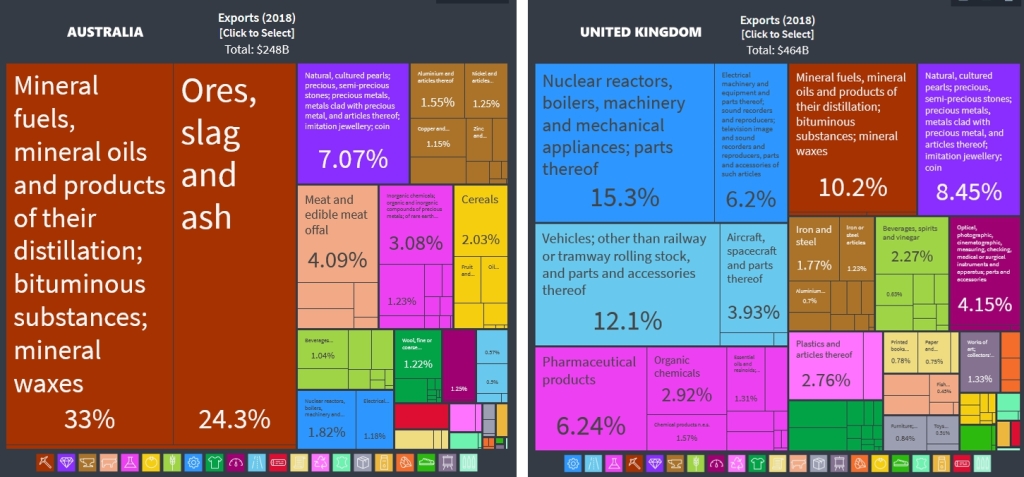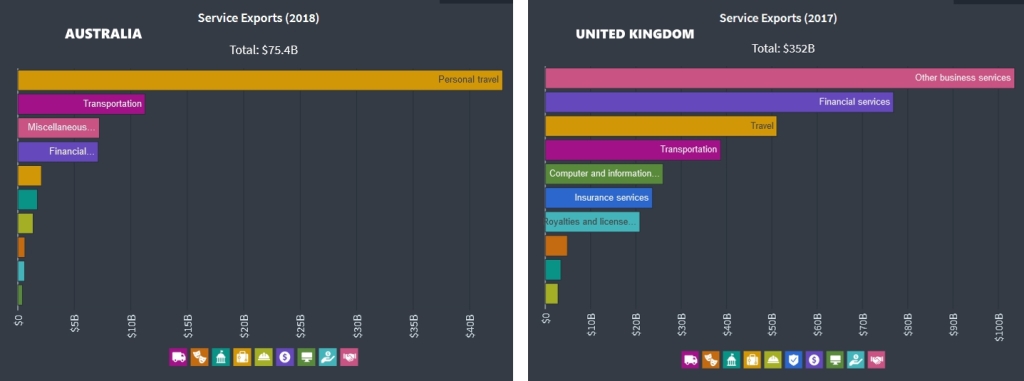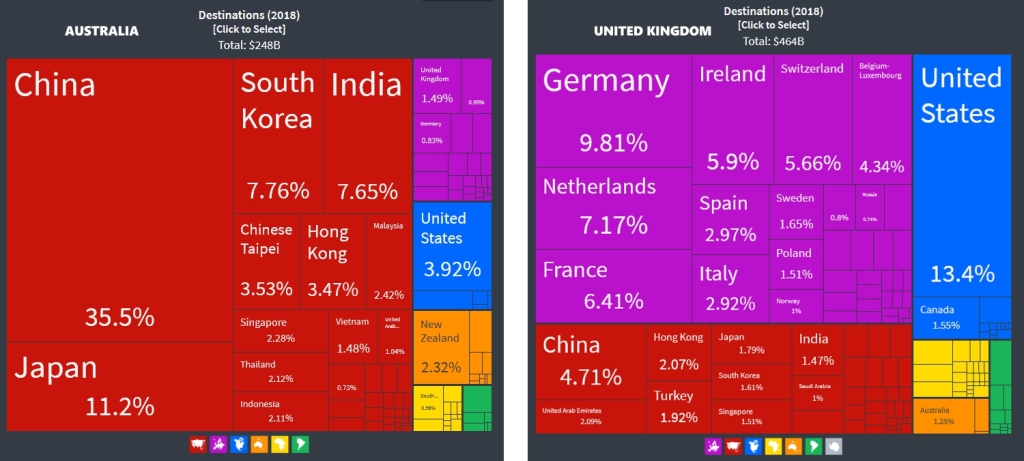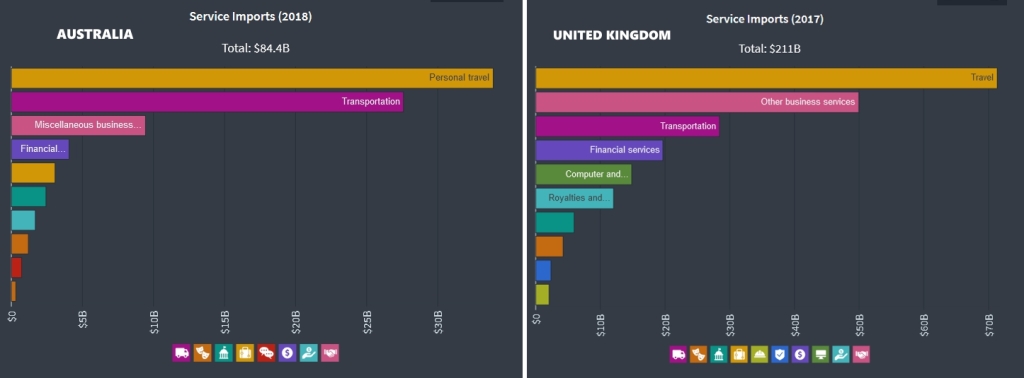By Peter Ungphakorn
POSTED NOVEMBER 30, 2020 | UPDATED DECEMBER 1, 2020
As the risk of failure in the UK- EU talks on their future relationship increases towards the end of the Brexit transition, the British government is trying to disguise “no deal” as if it were some kind of deal.
What Brexiters used to call a “WTO deal”, is now “An Australia-type relationship” in coordinated messaging from Prime Minister Boris Johnson, his Cabinet, and his supporters in Parliament. Among the latest is Environment and Farming Secretary George Eustice. He of all people should know better.
Continue reading or jump to
Australia’s deals with the EU | Incomparable trade profiles | Free trade agreements | More charts
The idea is that if Australia can flourish without a free trade agreement with the EU, then so can Britain. Johnson first used it in a speech at Greenwich in February 2020.
Two responses to that — setting aside the economic shock that the UK will face by totally dismantling near-friction-free trade with by far its most important trading partner.
First, without a deal with the EU, an Australian-style relationship is not available to the UK. To claim that it is, makes it a fig leaf that doesn’t work, or more accurately the Emperor’s New Clothes that can’t hide an embarrassment.
Second, if Australia is flourishing without a free trade agreement with the EU, that’s because Australia’s priority trade interests are closer to home — an important point for the UK, too.
In other words, with “no deal”, the UK’s relationship with the EU, and its trade situation in general, will be worse than Australia’s. Why?
- Because Australia does have some trade arrangements with the EU. Without a deal Britain won’t have any of them. They include Australia’s exclusive access to some of the EU’s tariff quotas for agricultural products — which is why Eustice should know better — and mutual recognition agreements, which cut red tape for product certification and other regulations
- The goods and services that Australia trades, including with the EU, are very different from the UK’s
- And importantly, Australia has free trade agreements with almost all its neighbours around the Pacific Rim
In order to have “Australian-type” access, the UK would have to reach agreement with Brussels. There would have to be some kind of deal.
(See also this article by Matt Bevington published by UK in a Changing Europe)

Australia’s deals with the EU
The EU’s treaty database lists 20 bilateral agreements with Australia (plus another 66 multilateral treaties). Over half (12) clearly contain provisions on trade.
One is a wide-ranging framework agreement, currently applied provisionally while waiting for ratification.
The others deal with: wine (with updates); mutual recognition of conformity assessment, certificates and markings (also with an update); air services; and amending the EU’s market access commitments in the WTO in general and to account for new EU members (updating earlier pacts on cheese, and on mutton, lamb and goat meat).
![]()
AUSTRALIA’S AGREEMENTS WITH THE EU
● Framework Agreement
● Crisis management — framework for the participation of Australia in EU operations
● Mutual recognition in relation to conformity assessment, certificates and markings — amending the agreement
● Passenger name record (PNR) data — processing and transfer by air carriers to the Australian Customs and Border Protection Service
● Security of classified information
● Trade in wine
● Passenger name record (PNR) — processing and transfer of European Union-sourced data by air carriers to the Australian customs service
● Air services — certain aspects
● WTO goods commitments and EU enlargement — exchange of Letters pursuant to Article XXIV:6 and Article XXVIII of GATT relating to the modification of concessions in the schedules of the Czech Republic, Estonia, Cyprus, Latvia, Lithuania, Hungary, Malta, Poland Slovenia and the Slovak Republic in the course of their accession to the European Union
● Wine trade — amending the agreement● Scientific and technical cooperation — amending the agreement
● Mutual recognition in relation to conformity assessment, certificates and markings — Final Act — Joint Declarations
● Intelligent manufacturing systems — exchange of Letters recording the common understanding on the principles of international cooperation on research and development activities in the domain of intelligent manufacturing systems between the EU and the US, Japan, Australia, Canada and the EFTA countries of Norway and Switzerland
● Tariff quotas and wine — agreement for the conclusion of negotiations between the European Community and Australia under Article XXIV:6 (Annex I)
● Tariff quotas and wine — exchange of letters for the conclusion of negotiations under Article XXIV:6
● Scientific and technical cooperation — Declaration of the Council and the Commission
● Wine trade — Protocol — Exchange of letters
● Cheese — exchange of letters on the arrangement
● Nuclear material transfers from Australia to the European Atomic Energy Community — agreement — letters sent to Australia from Euratom Member States which do not have bilateral agreements with Australia — side letters
● Mutton, lamb and goat meat trade — exchange of letters
Tariff quotas. The EU’s market access commitments in the WTO, and earlier deals with the Australia on sheep and goat meat, guarantee Australia exclusive tariff-quota access to the EU market. (Tariff quotas are where limited quantities of imports enjoy low or duty-free access instead of much higher regular tariffs.)
Although they feature in the bilateral agreements, the governing document on tariff quotas is the EU’s list (“schedule”) of commitments on goods in the WTO.
The tariff quotas that the EU actually applies may be slightly larger than in the WTO commitments, but not much, if at all. The quotas that the EU committed in the WTO exclusively for Australia (current for the EU–28 and proposed for post-transition EU–27) include:
- Beef — current 7,150 tonnes (2,418 tonnes proposed for EU–27)
- Buffalo meat — 2,250 tonnes (1,405 proposed)
- Sheep/goat meat — 19,186 tonnes (3,837 proposed)
- Cheese for processing — 500 tonnes (proposed unchanged)
- Cheddar — 7,000 tonnes (4,361 proposed)
- Raw cane sugar for refining — 9,925 (4,961 proposed). This is not a product the UK exports and there are no tariff quotas for beet sugar.
Beef — roughly 80% of UK beef of all types is exported annually to the EU–27. That’s at least 80,000 tonnes, the actual amount varying by year.
Among the many categories of beef tariff quotas, without a deal the only ones the UK will be able to access are those open to imports from all other countries. Here, they are for frozen beef, with or without the bone. The EU is proposing tariff quotas of around 64,000 tonnes for all-comers from January 1, 2021.
Mutton, lamb and goat meat — the proposed tariff quotas available to countries without specific quotas or to all comers would be 378 tonnes. That’s less than 0.5% of UK exports to the EU–27, currently around 80,000 tonnes.
Cheese — there will be no tariff quotas available to the UK. The only tariff quotas EU–27 has for “cheese for processing” are specifically for Australia and New Zealand, no one else. For “cheddar” its proposed tariff quota for non-specified countries (including the UK) is zero.
In other words, without a deal, the UK’s access to EU tariff quotas will be zero or tiny, compared with its current unlimited duty-free exports to the EU–27.
Mutual recognition agreements. These are always complicated because many different types of products are involved, each with different requirements. The EU-Australia mutual recognition agreement currently covers:
- Automotive products
- EMC (electromagnetic compatibility)
- Low voltage equipment
- Machinery
- Medical devices
- Pressure equipment
- TTE (radio and telecommunications terminal equipment)
- GMP (good manufacturing practice)
The agreements involve recognising each other’s companies and agencies issuing conformity assessments, certificates and special marks. Therefore each has provided lists of conformity assessment bodies. The EU has about 60 bodies recognised by Australia. The EU recognises three from Australia — not an impressive number.
If the EU recognised only three UK conformity assessment bodies, that would add to the disruption for British exports. But with “no deal” none would be recognised.

Incomparable trade profiles
Australia and the UK export very different goods and services, to very different markets.
Well over half of Australia’s goods exports are minerals, oils and metals. The UK’s goods exports are considerably more diverse. Leading categories are various types of machinery, vehicles and aerospace equipment, and pharmaceuticals and chemicals.

The same applies to services exports. Completely dominant — two thirds of exports— is “personal travel”, which includes visits to Australia for tourism, medical treatment and education with stays of less than a year (UN Comtrade definition).
Again the UK is considerably more diverse, with business and financial services in the lead. Selling those services is much more complicated than welcoming travellers because generally it involves setting up operations abroad for customers who do not travel. Without a deal with the EU, market access and regulatory barriers go up. (Types and modes of services trade are explained here.)

Finally, their goods export markets are very different, or rather, they are similar in that Australia and the UK both export predominantly to their neighbours. The vast majority of Australian exports go to Asia. The UK is slightly more diverse but half still goes to its continent, Europe.
That’s also the case with imports. Over half of Australia’s goods imports come from its Pacific Rim neighbours.
So the reason why Australia has flourished is not despite having no trade agreement with the EU, but because — like everyone else — its priority markets are nearby. Geography counts.
And that explains the free trade agreements Australia has concluded.
(On the import side, Australia and the UK are more similar. See the charts below)

Free trade agreements
For Australia, a free trade agreement with the EU has not been a priority until now. Its agreements have been with its neighbours around the Pacific Rim, big (like the US), small (such as the Pacific Islands) and everything in between. Geography counts.
Some agreements are bilateral such as with China — although political conflict has caused some trade friction. Others span the whole region, such as the Comprehensive and Progressive Agreement for Trans-Pacific Partnership (CPTPP). All of Australia’s agreements as notified to the World Trade Organization (WTO) are in this database.
Meanwhile the EU and Australia have now started negotiating a free trade agreement (as has the UK).
“A strong EU is vital to Australian interests in protecting and promoting a rules-based international order,” the Australian government says on its website pages on the talks.
“[…] An FTA [free trade agreement] would provide Australian exporters with a competitive edge and would give Australian businesses access to a larger export market in the EU. Australian consumers and companies stand to benefit from a free trade deal with the EU through greater access to goods and services at lower prices.”
Australia itself is not content with what the Johnson government calls an “Australia-style” relationship with the EU.
More charts
Sources: OECD Australia charts, UK charts



Updates:
December 1, 2020 — minor corrections and textual tweaks for clarity; adding UN Comtrade definition of “personal travel”
Image credits: Map from WTO regional trade agreements database. Ocean background photo Magda Ehlers via Pexels (CC0). Charts from OECD. Emperor’s new clothes, Koninklijke Bibliotheek (CC BY-SA 2.0)


